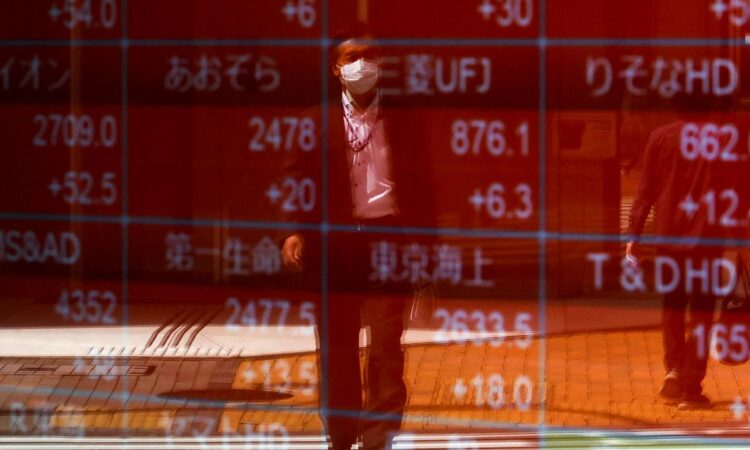
[1/2]A man is reflected on an electric stock quotation board outside a brokerage in Tokyo, Japan April 18, 2023. REUTERS/Issei Kato/File photo Acquire Licensing Rights
TOKYO, Sept 26 (Reuters) – U.S. Treasury yields scaled fresh 16-year peaks on Tuesday, keeping the dollar near a 10-month high, as investors responded to the message from the Federal Reserve and other major central banks that rates are likely to stay elevated for longer.
Asia-Pacific stock benchmarks sagged along with gold, with European equities also set for a weaker open, while crude oil continued to drift back from 10-month highs.
The yield on 10-year Treasury notes rose as high as 4.566%, a level not seen since October 2007.
The U.S. dollar index – which measures the currency against six major developed market peers, including the euro and yen – ticked up 0.09% to 106.04, after reaching 106.10 overnight for the first time since Nov. 30.
MSCI’s broadest index of Asia-Pacific shares (.MIAP00000PUS) slumped 0.66%.
Tokyo’s Nikkei (.N225) lost 0.93%, while Hong Kong’s Hang Seng (.HSI) slipped 0.98% and mainland Chinese blue chips (.CSI300) retreated 0.4%.
U.S. stock futures pointed 0.35% lower, following a 0.4% rise for the S&P 500 (.SPX) overnight. Pan-European STOXX 50 futures fell 0.17%.
Westpac strategists see risks skewed toward even higher yields in the near term, buoying the dollar.
“We expect 10-year yields to establish a new, higher, range in coming weeks,” with a possible peak around 4.75%, they wrote in a client note. “Medium term, we would be looking to get long at some stage, but that time is not yet upon us.”
The next target for the dollar index is 107.20, they said.
By contrast, IG analyst Tony Sycamore says technical indicators suggest a top for Treasury yields is close.
“I think that over the next three or four days, we’re going to see yields start to come off, and U.S. equities could start to base,” he said. “But between now and then, it could get more ugly, that’s for sure.”
Traders now put the odds of another quarter-point Fed hike by January at a coin toss, and have pushed the likely start of rate cuts to summer.
Chicago Fed President Austan Goolsbee said on Monday that inflation staying entrenched above the central bank’s 2% target remains a bigger risk than tight Fed policy slowing the economy more than needed.
Minneapolis Fed President Neel Kashkari said more rate hikes are likely needed given the surprising resilience of the U.S. economy.
The European Central Bank and Bank of England have also touted higher rates for longer in policy meetings since the middle of the month.
The relative outperformance of the U.S. economy – with investors increasingly betting on a soft landing while growth in the euro zone and Britain stagnate – has buoyed the dollar against those currencies.
The euro sagged 0.08% to $1.0584, approaching the overnight low of $1.0575, a level last seen in mid-March.
Sterling slipped 0.14% to $1.2196, taking it back toward Monday’s six-month low of $1.21945.
The dollar also held near an 11-month peak of 148.97 yen from overnight, raising the risk of intervention by Japanese authorities.
Gold drifted slightly lower to $1,914.15, extending its slump from above $1,947 over the past week.
Crude oil remained weak amid concerns that fuel demand will be crimped by major central banks holding interest rates higher for longer, even with supply expected to be tight.
Brent crude futures were down 38 cents at $92.91 a barrel, while U.S. West Texas Intermediate crude futures were trading 34 cents lower at $89.34.
Reporting by Kevin Buckland
Editing by Shri Navaratnam and Kim Coghill
Our Standards: The Thomson Reuters Trust Principles.




